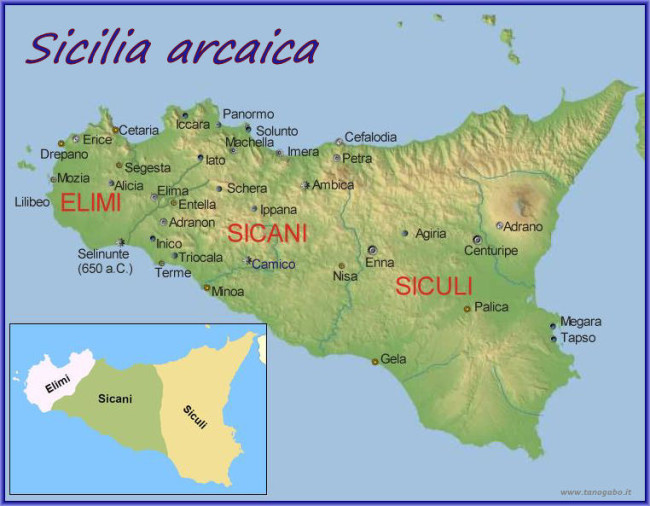 Sicily is the melting pot of Italy, a cultural mélange that has taken over 10,000 years to create.
Sicily is the melting pot of Italy, a cultural mélange that has taken over 10,000 years to create.
From around the 9th millennium BC till around 1200 BC the island was populated with farming communities. Their origins are a bit cloudy.
The Sicels (Siculi), the ancient namesake of Sicily, probably came from the Italian peninsula to the East side of the island. The Sicani might have come from Spain or Northern Africa to the West coast of the island. The Elymian claimed to be refugees from the Trojan War.
In the 2nd millennium BC, the Mycenaean of Greece put Sicily on the ancient map of the world. By the 1st century BC, the melting pot began to fill with Greeks, Carthaginians and Romans.
After the fall of the Roman Empire the island moved from the Vandals to Byzantines, Arabs, French Normans, German Hohenstaufen, Spanish Aragon, Austrian Hapsburg, Spanish Bourbon, Napoleon and the Italian Unification.
Even the British and Americans controlled the island for minute during World War II.
Most remember the Mycenaean as the antagonists of the Trojan War when King Menelaus of Sparta and his brother, King Agamemnon of Mycenae, sailed an army to Troy to rescue Helen and destroy the Trojans, which they did. The story was the Iliad, one of the greatest epic adventures of all time.
The 1st millennium BC blind poet, Homer, author of the Iliad and the Odyssey, (supposedly) came to Sicily sometime between 1200 BC and 800 BC.
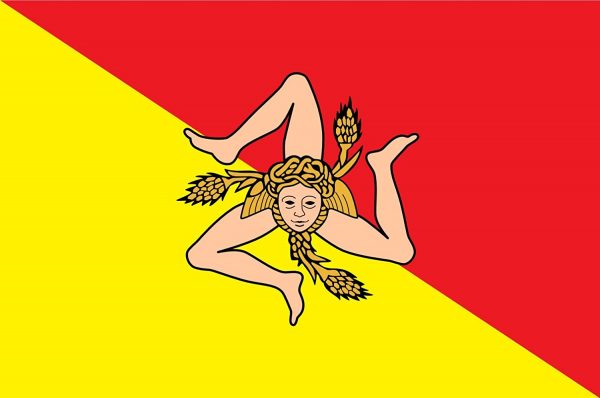 Homer called to the island Thrinakia for it’s geographically triangular shape. The symbol of Sicily is still known as the ‘trinacria’, the three legged head of the Medusa Gorgon.
Homer called to the island Thrinakia for it’s geographically triangular shape. The symbol of Sicily is still known as the ‘trinacria’, the three legged head of the Medusa Gorgon.
What attracted the Mycenaean to Sicily was the obsidian on the island of Lipari, the largest island of Aeolian Islands off the north coast of Sicily. Homer supposedly named the Aeolian Islands after Aeolus, the wind god.
There is a great episode in Homer’s Odyssey where Aeolus gives Odysseus (Ulysses) a leather bag filled with wind to help his journey back to Ithaca. Odysseus seals the bag and places it in the hold of the ship.
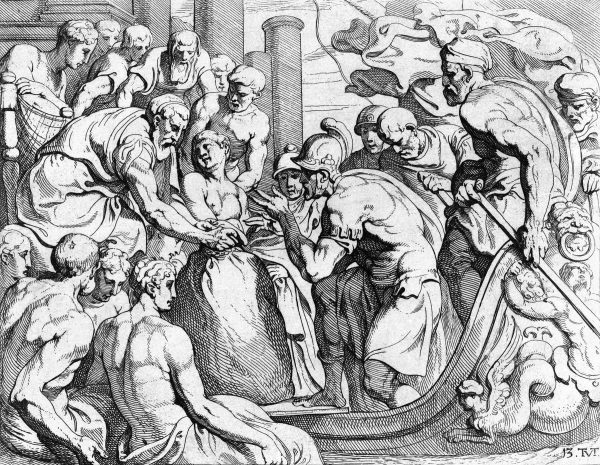 By the time Ithaca was in sight, the crew, convinced the bag contains a great treasure that Odysseus is hoarding for himself, break into the hold and untie the restraints. The wind, now free of its confine, fill the sail and carry the ship back to the Aeolian Islands.
By the time Ithaca was in sight, the crew, convinced the bag contains a great treasure that Odysseus is hoarding for himself, break into the hold and untie the restraints. The wind, now free of its confine, fill the sail and carry the ship back to the Aeolian Islands.
The Aeolians sit along a still active volcanic archipelago stretching from Mount Vesuvius in Campania to Mount Etna in Sicily. Lipari is home to the volcano Monte Pilato.
About 14,000 years ago, Pilato erupted. The lava flow gave the island the best source of Obsidian in the known world of 2nd millennium BC.
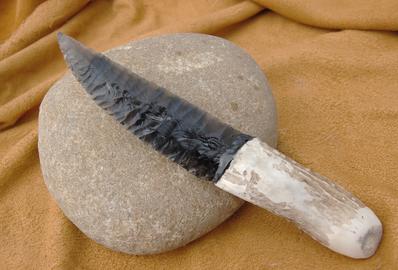 Black, almost glasslike Obsidian is a rare form of cooled and hardened lava. Most lava cools into pumice stone. Obsidian is the result of lava cooling very fast. It is hard, easy to form into weapons and much harder than the flint weapons popular in the Neolithic period.
Black, almost glasslike Obsidian is a rare form of cooled and hardened lava. Most lava cools into pumice stone. Obsidian is the result of lava cooling very fast. It is hard, easy to form into weapons and much harder than the flint weapons popular in the Neolithic period.
Volcanic obsidian glass could be chipped, honed and polished into razor sharp knives, axes and arrowheads.
Obsidian is still used in surgical knives. It’s also used to kill the white walkers in the game of Thrones saga. This YouTube video shows how obsidian arrowheads were made in the 2nd millennium BC.
Enter the Phoenicians
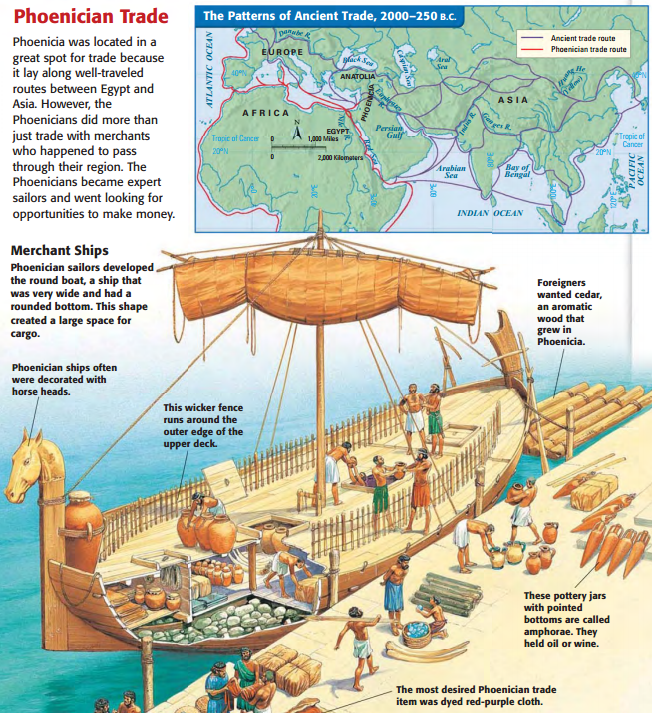 In the 10th century BC the Phoenicians arrived from Tyre (Lebanon) to Western Sicily.
In the 10th century BC the Phoenicians arrived from Tyre (Lebanon) to Western Sicily.
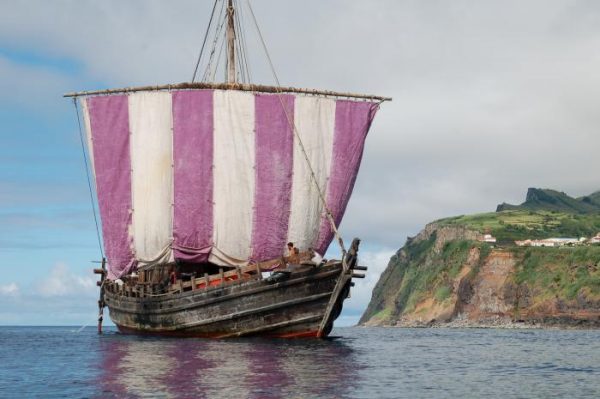 The Phoenician ‘gauloi’ or round ship was the first known long range seafaring ship, the first to sail from Lebanon to the Pillars of Hercules, the Strait of Gibraltar. The hull was round, the stern was curved and a giant rectangular sail in the center of the deck carried the Phoenicians to parts unknown.
The Phoenician ‘gauloi’ or round ship was the first known long range seafaring ship, the first to sail from Lebanon to the Pillars of Hercules, the Strait of Gibraltar. The hull was round, the stern was curved and a giant rectangular sail in the center of the deck carried the Phoenicians to parts unknown.
Phoenician merchants traded cypress and cedar from Lebanon, copper from Cyprus, silver from Spain, gold from Ethiopia, Ivory from India, glass and jewelry from Tyre, pottery from Greece, grain, papyrus from Egypt and slaves from Cilicia and Phyrgia (Turkey). They traded wool, linen, cotton and silk but is was the purple dye from the glands of the murex bolinus mollusk that made them rich and famous.
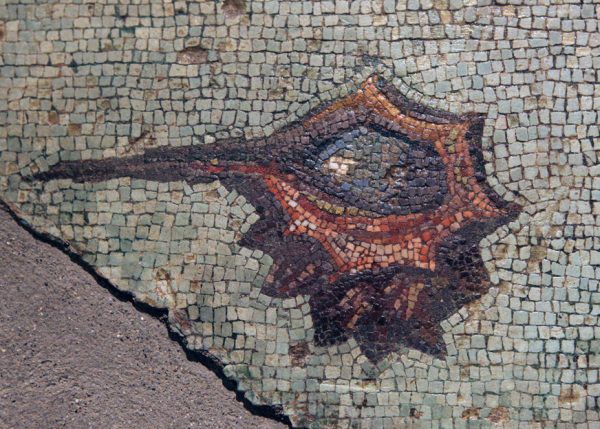
It took 10,000 of these conch-like sea snails to get 1 gram of the dye, enough to dye one robe, a robe so valuable only Kings and High Priests could afford one. It was one of the most prized and valuable luxury items of the ancient world.
During the Roman Empire ‘Tyrian purple’ was more valuable than gold. ‘Born in the Purple’ a term popularized during the Byzantine Empire, signified destiny and superiority of children born to the Royal family. The color became synonymous with wealth and power.
In the Levant (Lebanon, Syria, Israel, Palestine, Jordan) they were known as the Tyrians. The Greeks named them after the purple dye and referred to them as the ‘Phoinos’, the Greek word for dark red. Phoinos became Phoenician.
Although the Phoenician/Tyrians became fabulously wealthy, they weren’t so good at defending their city and by the 9th century BC, Tyre was conquered by the Assyrians. Most of the merchant trade moved to their colony in northern Africa, a place they called Carthage (New City).
The Tyrian/Phoenician became the Carthaginians.
Geographically, Carthage is southwest of Western Sicily and consequently the Carthaginians developed trading hubs on the west side of the island at Zis (Palermo), Himera (near Cefalu) Soluntum (Solunto) and Motya, an island stronghold (now San Pantaleo) off the coast of modern day Marsala where they harvested the murex bolinus mollusk and produced lots of the valuable purple dye.
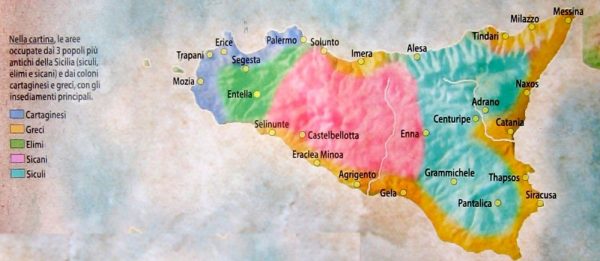 The Greeks Colonize on the East Coast of Sicily
The Greeks Colonize on the East Coast of Sicily
In 734 BC a group of colonists from Chalcis (modern day Euboea, Greece) built the 1st Greek settlement in Naxos (now Giardini Naxos) about 10km south of Taormina on the East coast of the Sicily.
In good weather Sicily was only a 12day journey from the motherland. They found the rich volcanic soil of Sicily to be perfect farmland, much better than the dry arid soil of Greece. Farm products from the colonies were traded for pottery, clothing, spices, tools and metal pots from Greece.
Over the next 100 years other Greeks city states set up farming colonies in Sicily at Katane (Catania), Leontinoi (Lentini), Megara Hyblaea, Siracusae (Syracuse), Gela, Akragas (Agrigento), Selinus (Selinunte), Lipari, Mylae (Milazzo) and Zancle (Messina).
For the most part the Greeks stayed to the East and the Carthaginians to the West. They occasionally interacted through trade but otherwise they pretty much stayed away from each other.
That all changed in the 5th century BC when the colony of Gela, a colony of Rhodes and Crete, began flexing it’s expansion muscle.
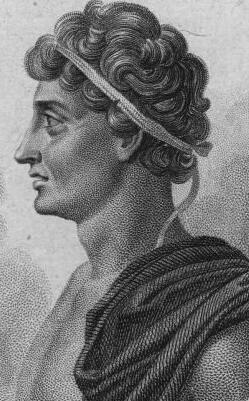
Under the rule of the Tyrant Hippocrates (498 BC – 491 BC) the Gelan conquered most of the neighboring colonies along the southeast side of Sicily. When Hippocrates was killed in a battle with the Sicels, his Cavalry General, Gelon took over.
Gelon consolidated all of eastern Sicily under his rule. He conquered those who would not yield to him, he married into the royal family of Akragas and he began to build Syracuse into what would later become one of the most important cities in the known world.
Gelon’s expansion did not go unnoticed by the Carthaginian colonies on the west side of the island and fearing they would soon be attacked, they mobilized.
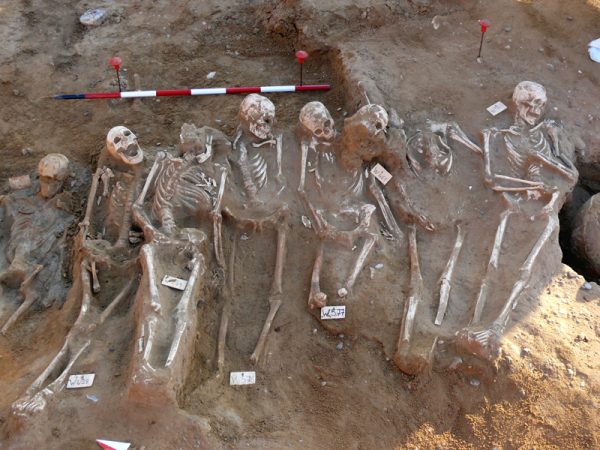
It all came to a head in 480 BC at the Battle of Himera, the first major conflict between the Carthaginian and the Greek colonies. In the end, 55,000 allied forces of Gelon thoroughly defeated 300,000 Carthaginians. Disclaimer: Historic battle numbers are often exaggerated by the victors of the battles.
Regardless of how many Carthaginians were defeated, the spoils and reparations from Carthage enabled Gelon to build his power base at Siracusae (Syracuse).
With the exception of a few years of peace here and there, Syracuse and Carthage stayed at war for the next 340 years.
Syracuse vs. Carthage, The Greek Punic Wars
In 734 BC, the Corinthians of Greece set up a small colony on the Ortega Island. Ortygia means Quail in ancient Greek.
The goddess Leto, daughter of Titans, was fleeing the wrath of Hera, wife of Zeus when she hid on the Ortygia Island and gave birth to her daughter, Artemis.
Nine days after her birth, Artemis helped her mother flee Ortygia and travel to Delos (about 1500km away) where Leto gave birth to Apollo. I know, they could have found someplace closer but remember, they were gods.
This is the usual explanation for the name of the island. However, the quail reference actually comes from Leto’s sister Asteria. Zeus (that old hound dog) disguised himself as an eagle and just as he swooped down to have his way with Asteria, she turned herself into a quail, jumped into the Aegean Sea and morphed into the island named for her. The Greeks were really good storytellers.
From Ortygia Island, the Corinthians enlarged the colony to the Syraka (swamp). The new city was appropriately named Syracusae (Syracuse).
Gelon transformed Syracuse with the riches he took from Carthage in the 480 BC Battle of Himera. His first public improvement was the new Temple to Athena.
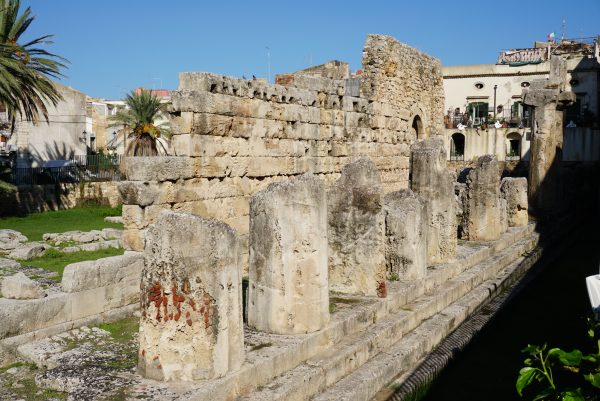
He more or less copied the design of the Temple of Apollo that built in Siracusa in the 6th century BC. The Apollo Temple is the oldest Doric style temple in Sicily. The Doric Style was popular in Greece from the 8th through the 5th centuries.
Doric Temples were characterized by simple flared capitals and decorated triglyphs and metopes on the architrave.
The Doric style is seen throughout all the ancient Greek Temples in Sicily. We’ll look at them in the following posts on Selinunte, Segesta and Agrigento.
The Temple of Apollo is now the centerpiece of the grand Piazza welcoming people to the Ortigia Island from the mainland.
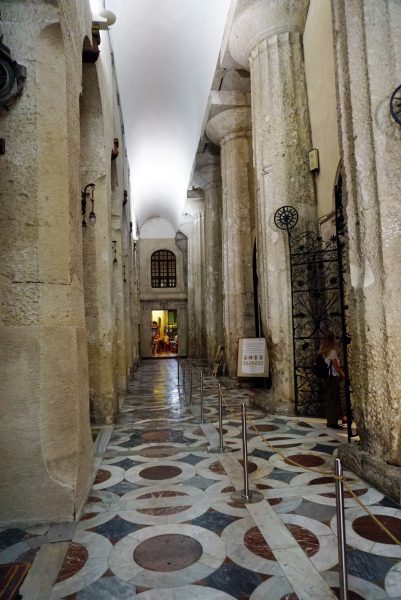
Gelon copied the Doric style Temple of Apollo with 6 columns at the front and rear and 14 columns along the side.
The real beauty of the Temple to Athena is that is still stands. It’s now called the Duomo of Syracuse. The Temple was converted into a church in the 7th century AD. The crepidoma, the multilevel substructure of the ancient Temple, is still visible from the exterior of the Duomo, so are many of the ancient columns. The real treat is in the inside of the duomo where the ancient columns and the cella still stand in all their 5th century BC splendor. These days there is a small charge to get into the Duomo.
Although the Duomo has been rebuilt many times the ancient Temple of Athena has not been altered. It has lasted through volcanic eruptions, earthquakes and bombings.
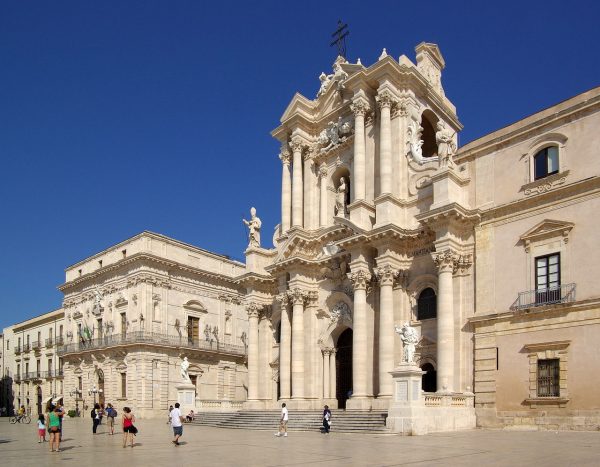
On March 8 1669, Mt Etna erupted and wiped out most of the eastern side of the volcano all the way to Catania. An estimated 20,000 people were killed.
Twenty-four years later, on January 11 1693, an earthquake damaged over 5,500 square miles, including Syracuse.
After the 2 major catastrophes in less than 30 years, Sicily was reeling. Money was going out but not coming in. The natural disasters also caused great damage to the exports of wheat, wine and lemons. Apparently Europe of the late 17th century was crazy for lemonade.
Artisans were available but hard marble and granite was costly. However, Sicily has an abundance of easily accessible beautiful red limestone that became the structural component of what is now known as Sicilian Baroque, all the splendor of embellished baroque decoration carved in limestone. The softer stone made it easier to carve and the results are wondrous, filled with curved facades, ornate balconies, grotesque masks and angelic putti.
But let’s return back to the ancient Greeks.
After the victory at the Battle of Himera, Gelon used Carthaginian prisoners as laborers and while the the Temple was under construction he also began work on a 46 km Aqueduct, now known as the Galermi Aqueduct. Much of the water flow was dug into the rock. Gelon, however, never really got see any of his projects. He died in 478 BC, two years after the victory at Himera.
His brother, Hieron, continued the Greek expansion, even crossing the Strait of Messina to the Italian mainland to defeat the invading Etruscans at the 474 BC Battle of Cumae (south of Naples). With every victory came more treasure. Hieron gave the city wealth, a ruling class, temples, civic buildings and unfortunately history’s first secret police force.
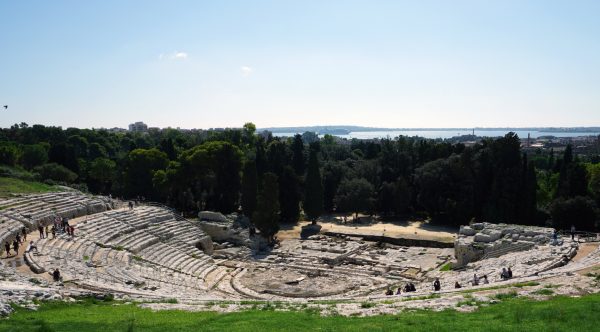
One of Hieron’s gifts to Syracuse was the beautiful hillside theater that still stands in the Parco Archeologico della Neapolis, an easy 20 minute walk from the Ortygia Island.
The theater was enormous for it’s time with 59 rows of seating, capable of seating 15,000 spectators. The Theater of Dionysus on the Acropolis Hill of Athens, built around the same time, had a capacity of 17,000.
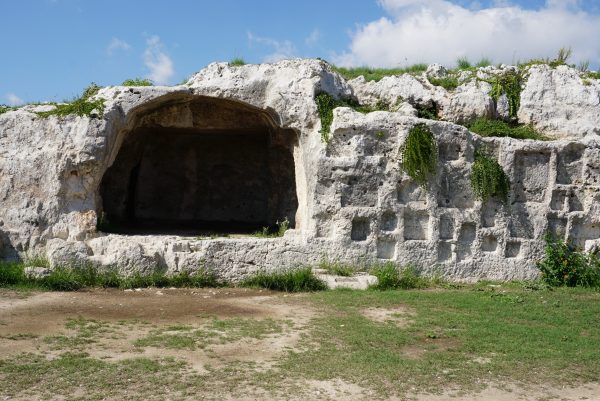
Underwater springs flowed through the carved out stone into cascading fountains. The walls around the theater were filled with ex-voto offerings. You can still see the carved alcoves that once held the votives.
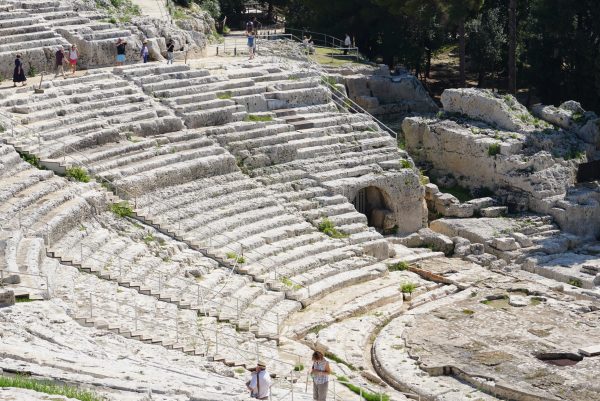 During the early years of the theater, there were contemporary plays performed by Aeschylus, Simonides and Pindar who happened to be living in Syracuse at the time.
During the early years of the theater, there were contemporary plays performed by Aeschylus, Simonides and Pindar who happened to be living in Syracuse at the time.
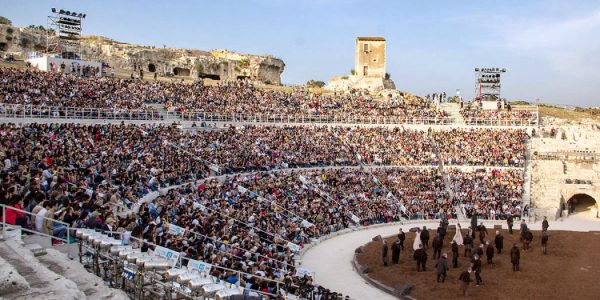 The theater is still performing plays by Aeschylus and others every May through June fro the ancient Greek Theater Festival http://www.indafondazione.org/en/
The theater is still performing plays by Aeschylus and others every May through June fro the ancient Greek Theater Festival http://www.indafondazione.org/en/
When Hieron died in 467 BC, Syracuse controlled more than half of Sicily.
The Peloponnesian War and the rise of Dionysius
In 431 BC the Delian League or the Empire of Athens went to war against the Peloponnesian League of Sparta. Athens was the most powerful City State in Greece before the war. When the war ended 27 years later, Sparta was victorious and Athens was broken.
When a truce was declared 10 years into the long war, Athens made use of the pause with an attempt to refill their coffers and damage Sparta economically. Their solution, invade Syracuse.
In 415 BC, Syracuse was the wealthiest city on Sicily and one of the wealthiest cities in the ancient world. Athens had a much larger military force and thought Syracuse would be an easy target. With control of Syracuse they would then gain control of the vast sources of grain, the major export of Sicily. Sicilian grain fed most of the Peloponnesian League and Sparta. Without it, Sparta would starve.
The proposed invasion was further encouraged by a plea from Egesta (Segesta), the Elymian colony on the west side of the island who were having problems with the Syracusan ally, Selinus.
The Egestan offered Athens a down payment for ships and troops and promises of untold wealth after the war. The conflict between Egesta and Selinus got much bigger. I’ll come back to it later.
In 415 BC, Athens deployed 100 ship and 5,100 soldiers, archers, javelin throwers, sling throwers and cavalry. By the end of the 2nd year of the conflict they had invested 200 ships and over 10,000 warriors to the battle.
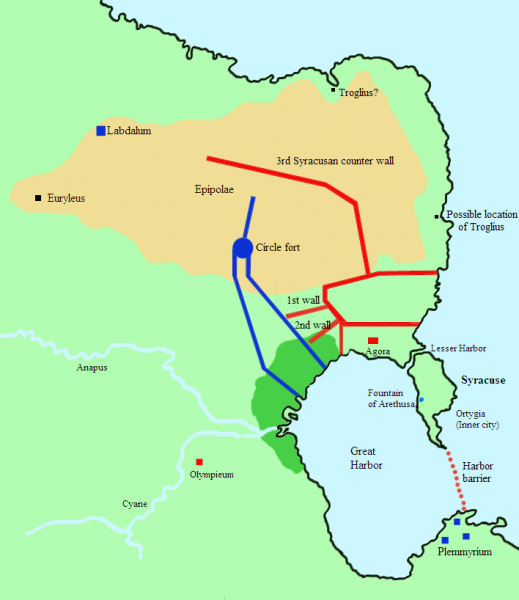
By the spring of 414 BC and both sides began building walls.
The Athenian walls prevented reinforcements and supplies from getting into Syracuse. The Syracuse walls bypassed the Athenian walls and provided access and supplies to outlying forts and reinforcements. Walls were constantly knocked down and rebuilt.
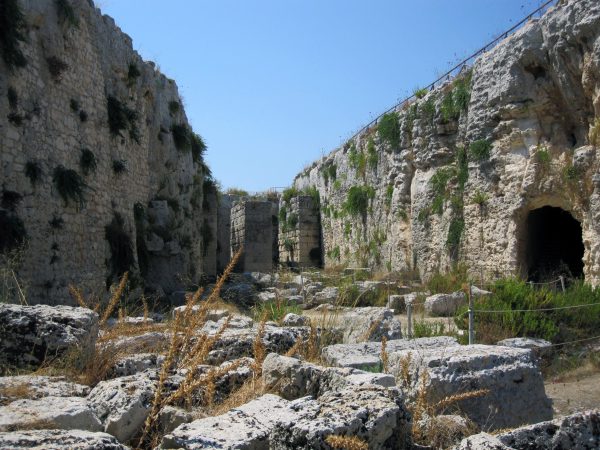
The best remains of the 414 BC fortification walls are at the Eurialo (Euryalis) fortress, about 9km outside of the modern city. Euryalis is large headed nail in ancient Greek.
If you don’t have a car, you can take a city bus (either the 25 or 26 Monday – Saturday or the 11 on Sundays and Holidays. Tickets are available at Tabacchi shops. Ask for Castello Eurialo. There is a charge of to get in.
The Siege was turning bad for Athens. Their Sicilian allies were inept. Syracuse had great horsemen and the best-trained fighters on the island. Even though Athens kept sending reinforcements, they just couldn’t win the war.
Two years into the siege the Athenians finally gave up and agreed to retreat back to Athens. Then, on the night of August 28, 413 BC there was a lunar eclipse. Nicias, the commander of the Athenian forces thought it an omen and appealed to the Priests for an explanation. They advised to wait 27 days before departing. It turned out to be really bad advice.
The 27 days was more than enough time for the Syracusan General, Hermocrates to finish off Nicias and the Athenians.
The Syracuse navy blockaded harbor, pinning the Athenian ships inside. With no room to move they were rammed and destroyed. The Athenian soldiers tried to escape but they were either killed or taken prisoner.
In the end, over 7,000 Athenians and their Sicilian allies taken prisoner.
Normally the prisoners would have been sold off into slavery but instead, Hermocrates forced them to work in the stone quarries north of the city. All 7,000 died of malnutrition and exposure.
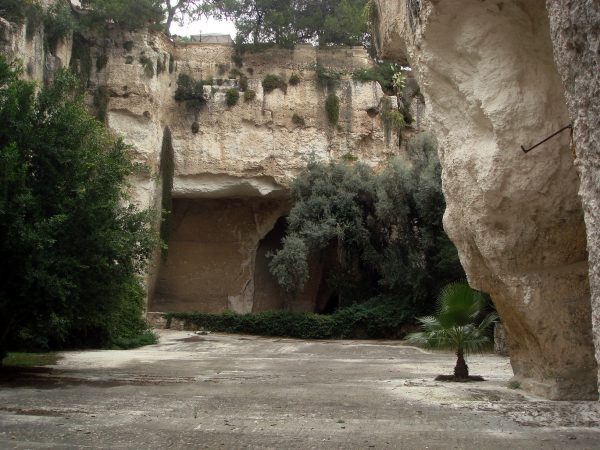
The quarry is now a beautiful park known as Latomia dei Cappuccini, a 20 minute walk from the Ortygia island at the end of At the end of the Riviera Dionisio il Grande. They are only open Wednesday through Sunday 10am-6pm.
The quarry graveyard became Pagan necropolis, a Christian cemetery, a Capuchin Monastery in the 16th century (hence the name) and later a garden.
After defeating the Athenians, Hermocrates went on to fight for Sparta as the Peloponnesian War was underway again. Unfortunately a year after his defeat of the Athenians in Syracuse, he was defeated by the Athenians at the Battle of Cyzicus (modern day Turkey). He was stripped of his rank and died in a street fight in 407 BC while trying to stage a coup.
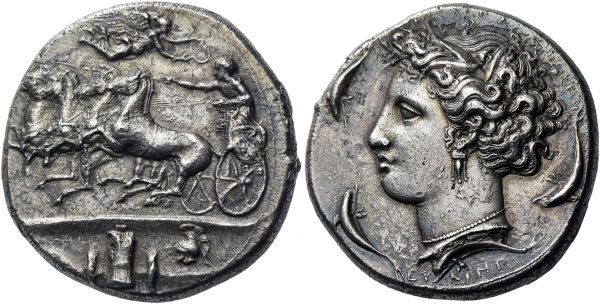
In 406 BC the military General, Dionysius was elected supreme military commander of Syracuse. During the war against Athens, he assembled a strong personal guard and using mind and muscle he succeeded in assuming the title of Tyrant of Syracuse. He ruled for 39 years.
Initially Dionysius created a peace with Carthage, giving them control of the Western side of the island while he took care of some unfinished business, basically destroying the colonies to the north that allied with Athens and selling off their entire populations into slavery.
When he finished with his local enemies, he set out to build a 27 km fortification around Syracuse. In less than 6 years he utilized the existing walls from the Athenian siege and fortified the castle at Eurialo.
Now that he had everything in place, he broke the peace with Carthage.
In 398 BC he set out west to destroy the communities that sided with Athens during the war. He then declared war on Carthage.
The conflict went on 20 years before Dionysius was victorious but the peace didn’t last very long. A year later they were at it again. When Carthage destroyed the Syracuse fleet off the coast of Lilybaeum, Dionysius decided to call the war off. The Peace that followed lasted 22 years but the wars between Syracuse and Carthage continued till the Romans came and wiped out both of them.
During his final years Dionysius turned his attention to his other love, theater.
He was named for Dionysus, the god of Theater and even considered himself a great playwright. He preferred the company of playwrights and poets and philosophers. Plato was one of the visitors to his court. In one version of his death, when he heard his play ‘The Ransom of Hector’ won the prize at the 367 BC Lanaia dramatic competition in Athens he was so elated, he drank himself to death at the age of 65.
Another version has him poisoned by his son and successor, Dionysius II, who was pretty much despised by everyone.
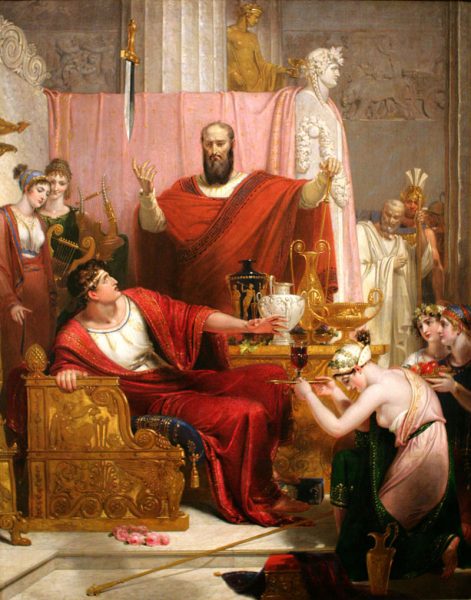
But with all of his accomplishments Dionysius gave to Syracuse, he is mostly remember for the sword of Damocles legend.
Damocles was a member of the court of Dionysius. He was a toady, flatterer, kiss-ass sycophant who sought personal gain through praise of Dionysius for his power, his wealth and his opulent feasts. Eventually Dionysius decided to show Damocles what it was like to have this power.
At the next feast Dionysius seated Damocles at his throne and made sure he was attended to with wine, food and servants. At some point during the feast Damocles looked up and saw a large sword hanging over his head, suspended by just a single hair from a horse’s tail.
Damocles, no longer wishing to be so fortunate, pleaded to Dionysius to be allowed to leave. Dionysius laughed and (supposedly) said, “with great power comes great fear”.
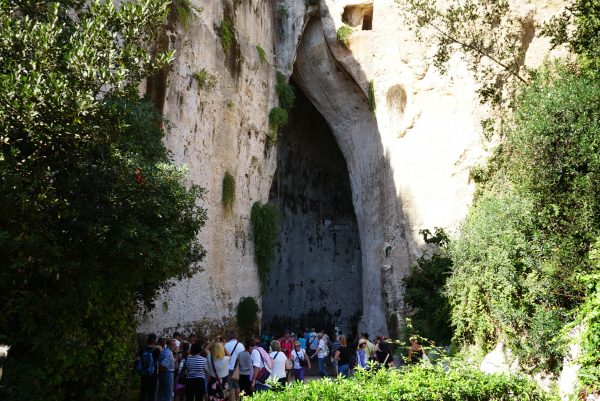
Another tribute to Dionysius was given to him in the 17th century by Michelangelo Merisi da Caravaggio who on a visit to Syracuse in 1585 named a 23meter tall limestone cave the ‘Ear of Dionysius’. The Ear is another one of the highlights of the Archeological Park Neapolis, and yes, the cave entrance does look like an ear.
In one legend, Dionysius put political prisoners in the cave and using the echo of the ear shape he could eavesdrop on their conversations.
Another legend has the echo of the ear amplifying the screams of tortured prisoners.
The cave was most likely dug during the Magna Graecia period. It could have been used for water storage or as a stone quarry but probably not as a torture camp for the enemies of Dionysius.
For those who look for Caravaggio paintings, his ‘Burial of Saint Lucy’ hangs in the church of Santa Lucia alla Badia near the Duomo on Ortygia Island.
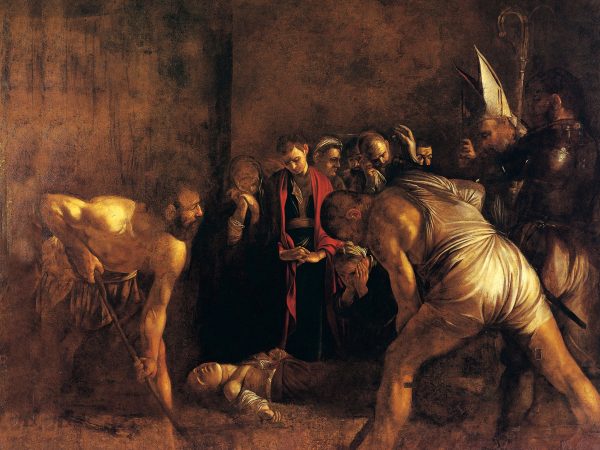
When Caravaggio fled from the prison in Malta, he arrived to Syracuse in 1608. He finished the Burial of Saint Lucy in 9 months. It was painted to hang in the Basilica of Santa Lucia al Sepolcro but Syracusan politics moved it to Santa Lucia alla Badia. The congregants of the Basilica of Santa Lucia al Sepolcro are still pissed off and have mounted many petitions to get it back.
If you have the time, make a visit to the Museo Archeologico Regionale Paolo Orsi. It’s a wonderful collection from the ancient Neapolis in a really beautiful building.
The Punic Wars – Enter the Romans
Rome and Carthage created a treaty of peace and trade in 508 BC but by the 3rd century BC, Rome became a more powerful nation coming off a string of successful campaigns on the Italian Peninsula. More land required more grain to feed the people. The Romans were looking to expand into Sicily.
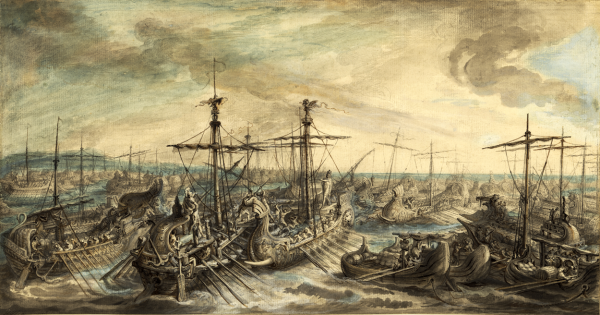
The first Punic War between Carthage and Rome lasted 23 years. Rome was new to naval battles. After a few disastrous defeats, she finally figured out how to fight on the water and victory went to Rome in 241 BC.
Twenty-three years after the 1st Punic War, Hannibal crossed the Alps and attacked Rome. So began the 2nd Punic War. This war lasted 17 years and in 201 BC, victory once again went to Rome.
After 10 years of Cato the Elder reciting ‘Carthago delenda est’ (Carthage must be destroyed), Rome finished the long war and completely destroyed Carthage in 146 BC.
In 215 BC, during the 2nd Punic War, a change of power in Syracuse also brought in an anti-Rome sentiment. Fearing Syracuse would unite with Carthage, Rome attacked.
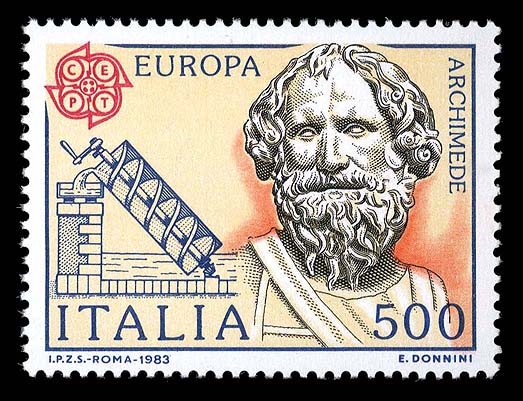 Archimedes
Archimedes
The Siege of Syracuse by the Romans lasted 2 years from 214 BC – 212 BC.
Rome was a much stronger fighting force but Syracuse had a secret weapon. His name was Archimedes.
This son of an aristocratic astronomer became one of the greatest minds of all time. He was a philosopher, mathematician, physicist, astronomer and inventor. Although he is most famous yelling, “Eureka, I found it” after discovering the calculation of density through displacement (the Archimedes Principle), his war machines were the reason it took 2 years for Rome to defeat Syracuse.
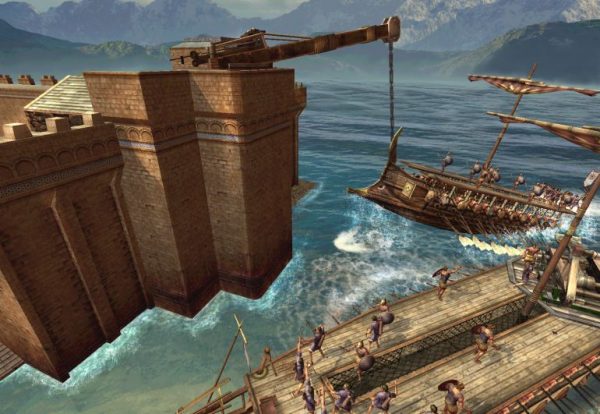 His giant Claw would grab onto ships and lift them out of the water and destroying them.
His giant Claw would grab onto ships and lift them out of the water and destroying them.
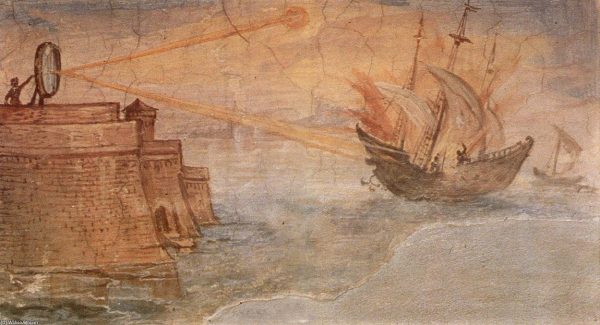 His Heat Ray using a parabolic reflector and capturing the rays of the sun to burn enemy ships.
His Heat Ray using a parabolic reflector and capturing the rays of the sun to burn enemy ships.
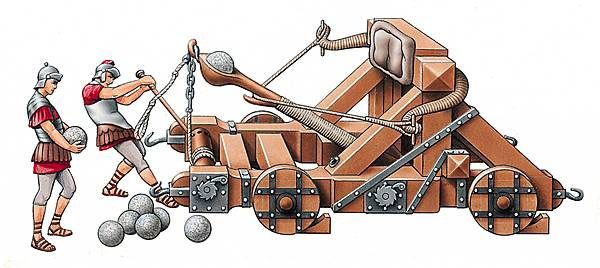 His bow loaded catapults were wheeled through the tunnels of the Eurialo Castle with ease, giving them the ability to attack the invading forces for several sides.
His bow loaded catapults were wheeled through the tunnels of the Eurialo Castle with ease, giving them the ability to attack the invading forces for several sides.
The inventions of Archimedes went way beyond war machines.
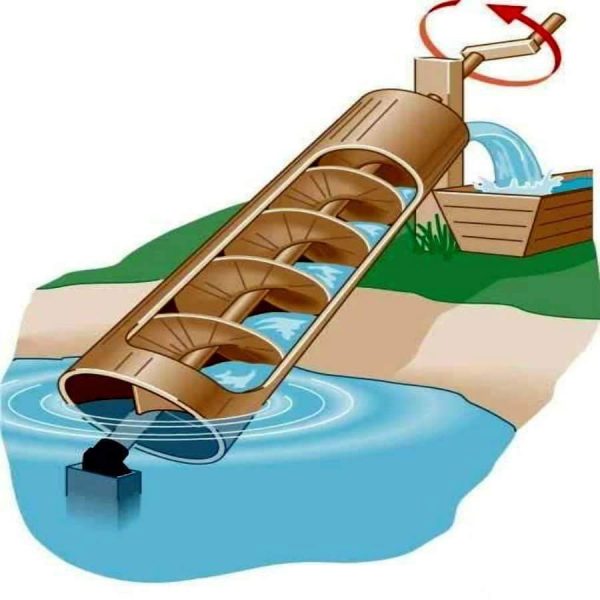 His hand cranked bilge pump (Archimedes Screw) is still used today.
His hand cranked bilge pump (Archimedes Screw) is still used today.
He designed compound block and fall pulley systems and fulcrum levers.
He invented the odometer to calculate distances.
The displacement theory that caused him yell ‘Eureka’ began with a request from King Hiero II when the King asked Archimedes to verify if a gold crown he had recently commissioned was indeed made entirely of gold.
As Archimedes was taking a bath he noticed that his body displaced the water and came to the conclusion that if the crown was pure gold it would displace more water than if it was mixed with a cheaper and lighter metal. He was right and so he ran naked through the streets yelling “Eureka!” The King had been cheated.
When the Romans finally entered the city in 212 BC, General Marcus Claudius Marcellus gave the order not to harm Archimedes. He would have been the greatest prize to bring back to Rome.
Unfortunately when a Roman soldier entered his house, Archimedes was working on a new design and screamed at the soldier to move away from the drawings. Instead the soldier killed him.
The year 212 BC marked the end of Magna Graecia. It never survived the Roman Empire.
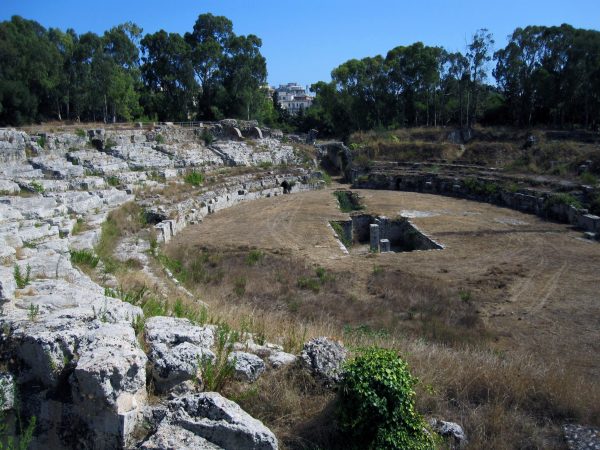
One of the first things the new Roman community did was build one of the largest amphitheaters in Sicily. It measures about 140 meters by 119 meters, around the same size as the Amphitheater in Verona.
Most of the stone was repurposed in the 16th century but the amphitheater still exists in the Archeological Park Neapolis.
Syracuse after the Romans
From Roman occupation, Syracuse moved into the hands of the Byzantines, Vandals, Ostrogoths, Arabs, French Norman and Angevin and Spanish Argonese.
At the end of the 17th century, many cities in Europe were removing cramped medieval streets in favor of broad geometric street plans leading into large Piazze.
Ortygia is now defined by its 17th century piazze; Piazza del Tempio di Apollo, Piazza Archimedes and the Piazza del Duomo were just a few of the grand squares that emerged from the narrow medieval streets.
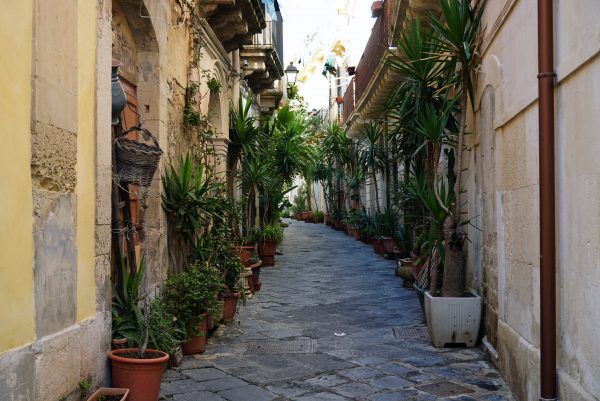
The little island is usually filled with people, locals and tourists alike. The is nothing like meandering through the ancient medieval streets, not knowing where you’re going and always ending up somewhere wonderful.
Traditions of the 13th century Holy Roman Emperor, Frederick II, Il Stupor Mundi (the astonishment of the world) are still remembered through the large puppet shows, L’Opera dei Pupi. These 40″ tall marionettes recreate the epic poem, the Song of Roland, set during the 8th century when Roland, a Knight of Charlemagne, fights against the Moors of Spain. The poem became very popular during the Crusades of the 12th and 13th centuries. The italian version of the poem, Orlando Furioso was written in the 16th century. It’s mostly the same as the French version, but with the added enjoyment of fantastical creatures like the the flying horses known as ‘hippogrifs’.
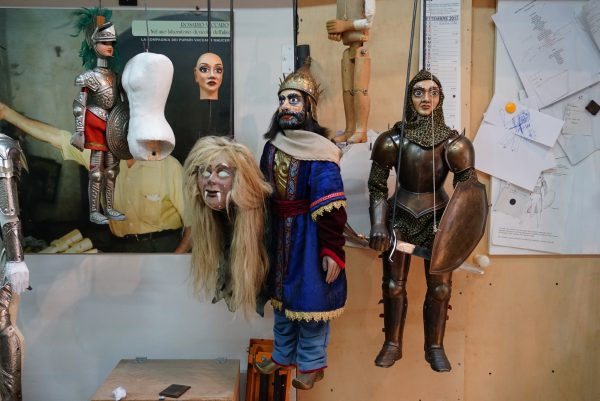
There are a couple of Pupi workshops in the old jewish Quarter of the Ortygia Island. It’s here where the puppets are created and restored. They can take a good beating during the performances.
The Teatro dei Pupi is a great example of serial drama, episodes and cliff-hangers. Each week a new chapter of the story unfolds.
Each performance is 1hr long and costs around You have to come back every night to find out what happens next.
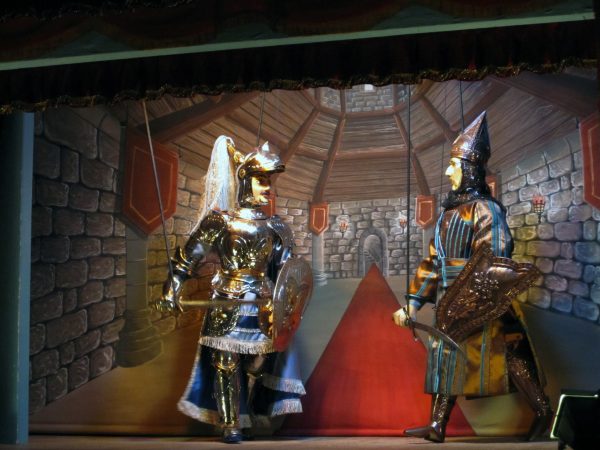
The plays have lots of action. Within 5 minutes there is a sword fight. At the end of the performance there were at least 10 puppet corpses piled up on the stage, some of them beheaded. It’s quite a puppet show.
At the end of the tale, there is a break in the schedule and then it begins all over again.
CLICK HERE to see more abou the ancient Greeks of Sicily at Segesta and Selinunte.
You must be logged in to post a comment.